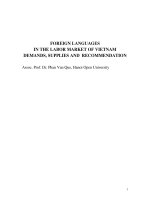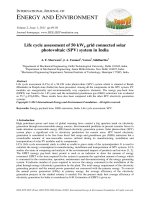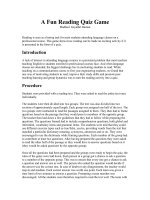26386 reading quiz languages in india
Bạn đang xem bản rút gọn của tài liệu. Xem và tải ngay bản đầy đủ của tài liệu tại đây (98.16 KB, 1 trang )
Name:_________________________________ Date__________
English III
Reading Test
Read the following text carefully:
Languages in India
India - a land as large as a sub-continent is bound to have many languages and the number of
languages in India justifies its size. There are 15 official languages and hundreds of local dialects.
Such a plethora of languages make an average Indian a linguist. On an average, every Indian speaks
two languages and in cosmopolitan cities like Mumbai, Delhi and Bangalore people can speak up to
three languages.
Indian languages are grouped under two families - Dravidian and Indo-European. All the south
Indian languages are grouped under Dravidian family. Tamil, Telugu, Malayalam and Kannada are
spoken in the states of Tamil Nadu, Andhra Pradesh, Kerala and Karnataka respectively. The
languages are different but resemble in having rounded alphabets. They have many Sanskrit words in
their vocabulary, but their grammar is entirely different. On the other hand Hindi, the language spoken
all over north India and in some parts of east India, belongs to the Indo European family of languages.
It has evolved from various transitional forms of Sanskrit over a long period of time. Being the
national language it is widely spoken all over India, but it is more prominent in the northern parts of
the country. Other languages like Punjabi, Gujarati, Garhwali, etc. are modified forms of Hindi, which
have evolved by the mixing of the local dialects. Apart from the widely spoken Indo-European and
Dravidian languages there are lesser-spoken Mon-Khmer and Sino-Tibetan languages, which account
for 2% of the total population. These are mostly spoken in the Northeastern India.
One will be surprised to see so many languages existing together. More surprising are the common
factors in these languages. Many languages not only share vocabulary with each other but also share
the script. Hindi and Marathi (spoken in Maharashtra) have a common script. Bengali and Assamese
too share a common script. All the Indian languages are written left to right except those written in
Persian scripts (Urdu & Kashmiri).
Source: />
Write whether the following statements are
true or false.
5. Hindi is spoken all over north India and
in some parts of east India ___________
1. According to the text, there are 15
language families in India.__________
6. The author argues that there are several
common factors in these languages like
vocabulary and script. That means that all
Indian languages are derived from Hindi
____________
2. On an average, Indian people speak two or
three languages_____________
3. Dravidian and Indo-European are the most
spoken languages in India. ___________
4. Hindi, Tamil, Bengali and Assamese have
a common script.______________
1.
7. Hindi belongs to Indo European family of
languages. That means that Hindi has been
influenced by European languages like Italic
and Germanic languages ____________









